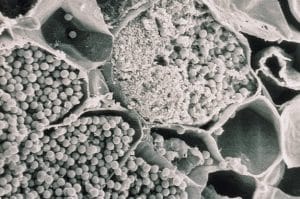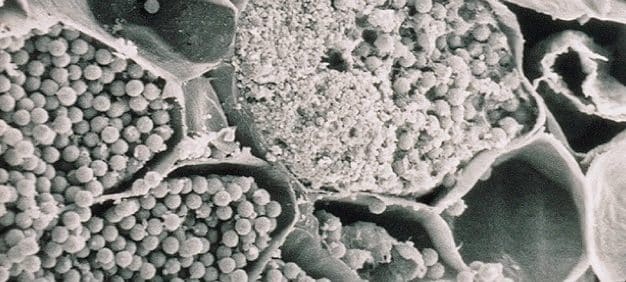1. How does clubroot spread? Each gall releases many spores into the soil. According to a German study, within one month after clubroot infects a plant, 66 million spores per infected plant are already propagated. This amount becomes significantly higher as the galls progress and enlarge. Spores don’t need host residue to survive. They can survive in the soil all on their own, and when soil moves – on machinery, boots, wind, water – clubroot can move. Read more about spores and the disease cycle.

2. Can I bring clubroot to my farm when buying used machinery? Yes. Based on several reports and direct conversations with concerned growers, the cleanliness of equipment seems to range from spotless to very dirty. This could depend on expectations of the buyers and sellers in a particular region. With clubroot found across the Prairies, clean equipment should be the expectation of buyers everywhere. And clubroot isn’t the only issue. Unclean equipment can also carry noxious weed seeds, aphanomyces and other soil-borne pests. Read more.
3. Should I use my own combine to help a neighbour harvest? If the neighbour has clubroot and the combine is picking up soil, then yes, the combine could bring clubroot-infested soil back to your farm. It would be a shame for clubroot to limit good-neighbourliness, but if using your own combine, perhaps wait until your harvest is done. As a good neighbour, you may want to give your combine a good cleaning BEFORE starting on the neighbour’s field so you aren’t moving weed seeds and other pests, including clubroot, to the neighbour. Then empty the stone trap and elevators and blow out as much soil as possible before leaving the neighbour’s farm as well.
4. Do I need to grow a clubroot-resistant (CR) variety? If you have clubroot on your farm, then yes. If you’re in a known clubroot area, then yes. If you farm in the county/district/municipality next to a known clubroot area, you might want to grow CR varieties as a precaution. If you are well outside the clubroot affected region, then you can base the seed decision on other agronomic factors more important to you than clubroot resistance. If the variety of choice happens to have clubroot resistance, this shouldn’t deter you from growing it. There is no penalty. The Canola Council of Canada (CCC) encourages early deployment of clubroot-resistance genetics. (See more on CR variety performance data at the end of the article.)
5. Why are we being proactive on clubroot and reactive on blackleg? In other words, why do I need to use a CR variety before I have clubroot but you don’t recommend a switch in blackleg-resistant varieties until the disease gets serious? Clubroot, once it arrives, is virtually impossible to eradicate. Growing CR varieties before the disease takes hold in a field can prevent a sudden explosion of infection and spores within one season. Blackleg, on the other hand, is already endemic on Canadian soils. The CCC does not advocate ever growing a blackleg-susceptible variety in Canada. While crop losses from blackleg can be severe, the build up of pressure tends to be slower, allowing for deployment of different resistance sources. Plus, a three-year break between canola crops can basically eradicate blackleg, which survives on stubble, and not in the soil.
6. How long can clubroot spores survive in the soil? Studies from Eastern Canada suggest that within two years after a canola crop, up to 90% of spores will die. But some spores can stay viable for 10 years or more, with some reports indicating 17-20 years. Rotation away from canola for two or three years can greatly reduce the clubroot risk, but in high-spore fields, rotation can never eliminate the risk. For example, in fields with 100 million spores per gram of soil – a common amount in the Edmonton area – even a 90% reduction in spores leaves over one million spores per gram. This is enough to infect every susceptible plant sown in the field.
7. What can agronomists do to prevent spread? (1) Make field visits on foot, where possible. (2) When not possible to visit fields on foot (soil sampling by truck/quad, for example), try to enter and exit fields from places other than the farmer’s usual entry and exit points. (3) Keep scrapers and wire brushes on hand to clean wheels and wheel wells caked with mud. (4) Wear different booties for each field or, better yet, set up a simple boot bath. More details on these recommendations.
8. Where exactly is clubroot found in Western Canada? Alberta, Saskatchewan and Manitoba have maps showing counties, districts or municipalities where clubroot has been confirmed, but the location of individual fields is not shared. Alberta map. Manitoba map. Clubroot is confirmed in Districts 9A and 9B in Saskatchewan.
9. I have a clubroot patch in the middle of a field and that field hasn’t produced canola in years. How is that possible? While this scenario is less common, it is possible. Even if the field has never grown canola, the cultivator used to break up a hay field, for example, could have had clubroot-infested soil on it. Wind and water erosion can also move infested soil. Runoff could have carried infested soil over land to a low area in the middle of a field. Spores then just waited. Brassica weeds such as mustard, stinkweed and shepherd’s purse will host clubroot and form galls, so weeds in that low spot could have built up soil spore loads. If the field produced a canola crop many years earlier, plants in that clubroot-infested low spot could have had low to moderate levels of clubroot infection that went unnoticed. But those small galls would have stealthily released a potentially devastating amount of spores. When canola is finally planted in that field, the disease could be unexpectedly severe in that out-of-the-way patch. How clubroot spreads.
10. Are alkaline soils immune to clubroot? While pH above 7.3 has been shown in studies to greatly reduce the severity of clubroot, the disease can still survive and infect canola grown in these alkaline soils. So while the risk may be lower, high pH does not mean immunity. Plus, pH is often highly variable in a field. Fields can have patches with lower pH and clubroot could take hold within those patches. Ongoing work is being conducted in Alberta and much of this will be covered at the 2018 International Clubroot Workshop in Edmonton August 7-9. Save the date.
Got other clubroot questions? Contact us.
Choosing a CR variety. CR varieties are part of the Canola Performance Trials (CPT) program. Varieties included in 2017 CPTs included L241C, 6076RR, CS2000, 6090RR, 45H33 and 4187RR. Go to canolaperformancetrials.ca to compare performance for these varieties. A table of CR varieties is on page 18 of the Canola Variety Selection Guide. For another overview, open the 2017 CPT booklet and look at page 6 for small plot variety data by zone average, pages 9-12 for individual site data and page 13 for field scale data.
When comparing varieties in the CPT database:
–always remember to check the number of samples (n-value) of each variety being compared
–consider more than one year of data
–after performing a search of data, remember to scroll down and look at the sites closest to your farm (see the data table below the graphs AND the responsive map below the data table)
Further reading:
